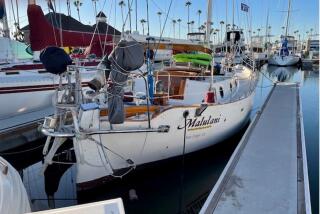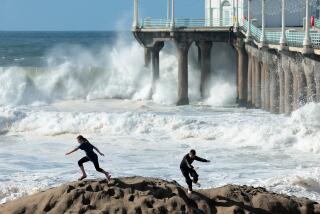Big-wave contest spawns ‘risk-technician’ courses
Most surfers say that what makes their sport special is its simplicity. They grab their boards, paddle out and become one with nature as they ride the swells.
But for some, surfing no longer is simple.
It has come to involve customized, heavier and much narrower boards that require expensive, jet-powered machines to be pulled onto waves that are too big and fast to be paddled into. This, of course, involves “tow-surfing” teammates who take turns driving those machines, and a knowledge of mechanics to keep them running.
And now, as big-wave surfers aspire to dangerous new heights, it has come to involve another component: a specialist whose job it is “to teach safety where safety doesn’t exist.”
Such a man is Brian Keaulana, 40, of Makaha, Hawaii, perhaps the world’s most famous lifeguard and undoubtedly one of its most respected “watermen.”
Keaulana, who has been recognized repeatedly for his life-saving efforts in the thunderous surf off Oahu’s North Shore, has been teaching ocean safety for years, mostly to other lifeguards. He pioneered the use of jet-powered rescue vessels--personal watercraft with special sleds--in heavy surf and has served as stunt coordinator and stuntman for more than a dozen wild-water movies and television shows.
His expertise in such a dangerous line of work has resulted in all sorts of interesting job offers, but perhaps none as interesting and intriguing as that presented recently by organizers of the Billabong Odyssey, a three-year expedition in search of the biggest waves on the planet with the ultimate goal of finding, and conquering, the heretofore unfathomable 100-footer.
Keaulana and partner Brock Little have been enlisted as the primary safety crew for what is arguably the most ambitious surfing expedition in history, one that will begin soon, most likely near the Oregon-Washington border, when the first winter storms start sending mammoth waves pulsating across the Pacific.
Being so close to the storms, this rugged coastline is exposed to the rawest of ocean power and expedition organizer Bill Sharp has mapped locations where gargantuan swells might best hold their shape.
It was also in this area--specifically, Cape Disappointment on the Washington side of the Columbia River--that opening ceremonies were held, two weeks ago, followed by one of Keaulana’s three-day “risk-technician” courses. His pupils were renowned watermen in their own rights: the tow-surfing teams of Shane Dorian-Ken Bradshaw, Ken Collins-Josh Loya, Darryl Virostko-Shawn Barron, and Mike Parsons-Brad Gerlach.
All had long-since developed considerable big-wave expertise, both on their boards and behind the controls of their jet-powered skis. But with such a daunting adventure ahead, all were willing to learn a little more--to enhance skills that might someday mean the difference between life and death.
“I got a ton out of it; everybody did,” said Parsons, a San Clemente surfer who last year made history--and $50,000--by conquering a 66-foot wave at Cortes Bank, a seamount 100 miles southwest of Los Angeles, during a contest rewarding the person who rode the biggest wave of the season.
“I was stoked because Brian Keaulana is the best lifeguard in the world. He trains Navy SEALs and people like that.”
Parsons said he and other surfers not only practiced the correct procedures of picking up fallen wave-riders in turbulent impact zones, but were given several scenarios to act on and then asked to discuss the reasoning behind their actions.
These included picking up, rescuing and reviving unconscious surfers; using group situations and identifying swimmers in need of the most immediate attention, then using the most prudent means to approach to rescue them, and rescuing imperiled swimmers in a state of panic.
“The main thing we learned is to have every scenario worked out before it happens, so when something does happen we can deal with it on auto-pilot,” Parsons said. “We’re not just reacting; we already have a full plan in place and do it.”
Coordination drills involved racing to pick up beach balls tossed into the surf zone. Strength and speed drills involved pushing the heavy jet-skis across the wet sand. Keaulana is no stranger to such conditioning: He gets in shape running across the ocean floor carrying boulders.
The Billabong Odyssey team, not surprisingly, passed with high marks.
Asked what role his risk-technician courses will play in surfing’s future, Keaulana would say only that the use of personal watercraft to pull surfers into bigger waves is increasing, and that some of those surfers might not know what they’re getting into.
“There are a lot of wannabes out there who want to wave their flag and shine, but technology is a double-edged sword,” he said. “It can enhance your knowledge and ability, but it can enhance your stupidity as well, and that can have an extreme negative effect.”
Three expeditions are scheduled each year during the Billabong Odyssey: two in the Northern Hemisphere between now and March, and one in the Southern Hemisphere during its winter between June and August.
Potential targets include remote islands within the Hawaiian chain, Chile, South Africa, Ireland, Tasmania, New Zealand and islands of the South Pacific.
The surfer riding the biggest wave each year will receive a cash prize of $1,000 per foot of wave-face height. A yet-undetermined prize, Sharp said, will be given to ‘any surfer successfully riding the legendary 100-footer.”
Already in progress, through March 15, 2002, is the Nissan Xterra XXL Big Surf Awards, awarding $50,000 (and an SUV) for the biggest wave ridden overall, $10,000 for the biggest paddle-in wave, $5,000 for the best overall big-wave performance, $5,000 for the largest wave photograph and $5,000 for the largest wave videotape.
It is an invitation-only event to keep those not qualified from possibly killing themselves (thus tarnishing the image of the sponsor). Surfers who have not been invited can petition for the right to participate. Details: https://www.surfline.com.
A Mammoth Forecast
Mammoth Mountain Ski Area is scheduled to open Nov. 8 and despite the country’s feelings of uncertainty as winter approaches, hotel bookings in town are up slightly from last year.
“What happens in the coming months will certainly have an impact on whether or not our guests will want to ski,” said Joani Lynch, communications director. “But my gut feeling is that people will be ready to get away with friends and family.”
Of course, she added, “The kind of winter we have will also play a big role in our visits this season--and it sounds like maybe things are aligning for El Nino-ish conditions. Again, only time will tell.”
During the El Nino winter of 1997-98, Mammoth received an incredible 540 inches of powder, 107 inches of it in January and 197 inches in February.
Softening the Blow
Cabo San Lucas’ annual “For Pete’s Sake” charity marlin tournament, which was nearly canceled because of the severe blow delivered a month ago by Hurricane Juliette, raised nearly $100,000 to benefit storm victims.
The tournament, held Oct. 18-20 in honor of Pete Lopiccola, a popular captain who died of leukemia before his 30th birthday, usually donates proceeds to the UC San Diego Cancer Research Center but this year diverted funds to help townsfolk who lost homes and jobs because of Juliette. The cancer center received a donation of $10,000.
Winner Ray Rodman of Albuquerque, aboard Tuna Thyme, won the tournament with the catch and release of two striped marlin and one blue marlin. In all, 12 striped and eight blue marlin were caught and released.
More to Read
Sign up for our L.A. Times Plants newsletter
At the start of each month, get a roundup of upcoming plant-related activities and events in Southern California, along with links to tips and articles you may have missed.
You may occasionally receive promotional content from the Los Angeles Times.






